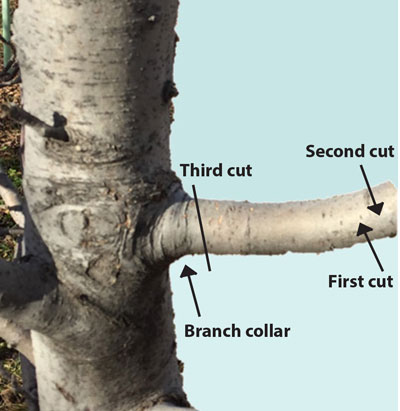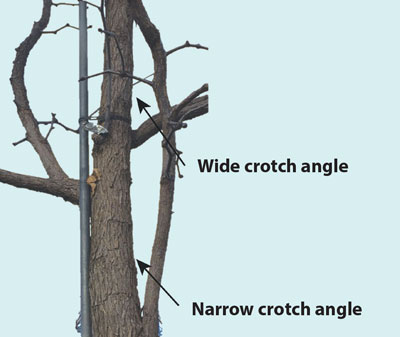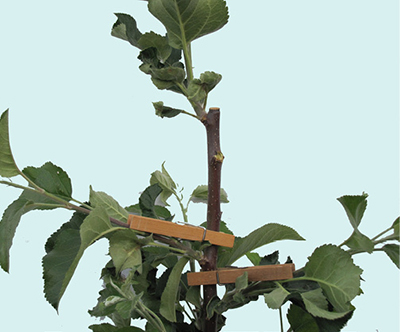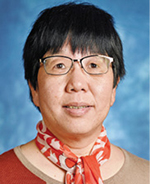Guide H-327
Revised by Shengrui Yao
College of Agricultural, Consumer, and Environmental Sciences, New Mexico State University
Author: Extension Fruit Specialist, Department of Extension Plant Sciences, New Mexico State University. Print Friendly PDF
Pruning basics
Fruit trees are pruned to regulate growth, increase yield, and improve fruit size and quality. Pruning is used to shape trees for ease of management and to repair damage. Many home gardeners also do pruning for decorative purposes. How you prune your trees affects the way they grow and how much they fruit.
Most pruning is done during the dormant season in late winter or spring, just before active growth begins. In north and central New Mexico, February to early March would be good time to prune. At this time, pruning wounds heal fast, flower buds are easily recognized, and injury from low winter temperatures may be avoided. In some areas, due to disease pressure, peaches have to be pruned after leafing, but not in New Mexico.
Pruning is also done in summer to train young trees to the desired shape, remove watersprouts and other undesirable growth, and maintain smaller tree size.
Basic pruning cuts
Before we get to the pruning details, here are three basic types of pruning cuts:
• Pinching: removes new growth near the ends of shoots (apical meristem) while it is still young and succulent.
• Heading cut: removes part—but not all—of a branch or shoot, which will stimulate new growth (Figure 1).
• Thinning cut: removes an entire shoot or branch at the base (at its point of origin), which does not stimulate new growth (Figure 1).

Figure 1. Heading cuts (1) remove only part of a branch or shoot, while thinning cuts (2) remove the whole branch or shoot.
Where to cut and wound dressing
When pruning trees, make the final cut close to the branch collar (the point where a branch joins the trunk or another branch). The branch collar is the wrinkled, swollen area at the base of the branch that contains tissue that will become active and seal the cut wound. It is critical to first remove most of the branch by making an undercut first, a few inches away from the trunk/branch collar, then finish from above (Figure 2). Make the third and final cut near the branch collar to remove the remainder of the branch. This prevents the weight of the branch from pulling down the branch as it is cut and damaging the bark on the trunk.
As for wound dressing, there are debates about whether it helps the tree heal or prevents healing. Plants do have their own self-protection and natural resistance mechanisms to heal wounds and fight attacks from insects and diseases. If pruning is done at the right time with sanitized tools and proper techniques, trees can heal themselves, and wound dressing is not necessary. If disease-prone trees have to be pruned when insects and fungi are active (non-dormant season), a coating of insecticide or fungicide is needed.

Figure 2. Branch collar and three steps of removing a branch.
Training Young Apple Trees
The first few years after planting are critical to train young apple trees with good permanent (scaffold) branches and to encourage early fruiting. The central leader system is suitable for apples and pears with 2–3 tiers of branches.
Those scaffold branches should have wide crotch angles with the trunk; branches with narrow crotch angles will split when they carry heavy crops (Figure 3). Wide-angled branches should be selected after planting if well-feathered trees are planted, or by the end of the first season for whips.

Figure 3. Branches with wide (top) or narrow (bottom) crotch angles.
If you plant one-year-old whips, simply head them at 29–36 inches (70–90 cm) for spur-type and semi-dwarf trees. Make sure there are several well-developed buds below the cut for your future scaffold branches. Otherwise the cutting height will need to be adjusted upward or downward. If trees are well feathered with lots of branches from the nursery, the usual practice is to head the leader 12 inches above the top branch, then select 3–4 wide-angled branches as the first layers of scaffold and remove the branches below 2 feet from ground. Make sure the 3–4 branches are well distributed around the trunk as well as along the trunk. No two selected branches should originate from the same height on the trunk; this may choke the trunk in the future. Cut back about one-quarter of the terminal growth of any wide-angled side branches, and make sure the first bud below the cut is facing outwards.
When the topmost buds on the central leader grow to 4–5 inches (10–12 cm), pinch off 1–2 buds below it (which tend to grow upright) to stimulate the lower bud growth with better angles. Clothespins can be used to adjust the branching angles for those future scaffolds when they are 5–6 inches long but still flexible. Attach the clothespin to the trunk and lay it on top of the new shoots to force them to grow flat (Figure 4).

Figure 4. Use clothespins to increase branching angle.
A well-trained central leader system mature tree will usually have 2–3 layers of branches with 3–4 branches for the first layer, 3 branches for the second layer, and 1–2 branches for the third layer (Figure 5). Apple trees can also be toped at two layers of branches for ease of management. See NMSU Extension Guide H-333, Training Young Apple Trees to the Central Leader System (https://pubs.nmsu.edu_h/H333/), for more detailed instructions.

Figure 5. Mature central leader system tree.
Limb spreaders are used as aids in establishing strong scaffolds and encouraging earlier production. Spreaders are especially useful in training varieties like Red Delicious that tend to form branches with narrow angles, growing more upright than spreading. Limb spreaders increase the crotch angle of scaffold branches. Cut 1-inch-by-2-inch boards into varied lengths. Drive No. 8 box nails into each end, cut off the nail heads, and sharpen. The sharpened nails hold the spreader in place. If the nails are hard to handle, growers can also use 2-inch-wide and 1/2-inch-thick boards of various lengths with a “V” nock on each end.
Apply spreaders early, while the limb is still pliable enough to be trained to the desired position. Spreaders are usually removed after two growing seasons. After selecting the framework of scaffold limbs, you will not need to do much pruning until the trees come into bearing. You may have to remove some branches that compete with the central leader or selected scaffolds, and occasionally do light corrective pruning.
Pruning Bearing Apple Trees
When trees start to produce, the fruiting will slow down the vegetative growth and make the pruning easier. For mature tree pruning, avoid heading cuts, which can stimulate too much vegetative growth. Instead, make a few large thinning cuts, either removing an entire branch or cutting a big portion back to a vigorous, fruitful lateral branch.
• Stand back from the tree to get a whole picture first, and imagine the tree you prefer. Figure out the main issues with the tree, and check back during the pruning process.
• Remove watersprouts; diseased, broken, and insect-injured branches; and weak, low-growing, and shaded branches.
• Reduce the tree height. Apple trees used to grow to
20–25 ft tall, but now people prefer to keep growth lower to the ground and more manageable by heading the top limbs to strong, out-growing laterals.
• Try to open up the top to allow sunlight to filter through the tree’s center by sensible removal of higher branches.
• If two branches overshadow, cross, entangle, or compete with each other, try to remove one completely from the base instead of cutting both short.
• Make sure that branches or limbs are as equally spaced around the tree as possible.
Neglected apple tree pruning
For neglected mature trees, a training system is no longer that important. Remove damaged, broken, diseased, and insect-injured branches first, then lower the tree height and remove overcrowded branches, and make room for good light penetration and air circulation for the branches you want to keep, which will improve fruit quality. Also, do moderate pruning for the first year and then prune them regularly in the following years. Do not remove several consecutive big branches in one season, which can greatly weaken or even kill the tree.
Pruning Pear Trees
In general, pear trees are trained like apple trees. The average young pear tree tends to become tall and leggy. Tipping or heading back the long shoots slightly encourages the development of side branches. Limb spreaders are especially useful in developing scaffolds in the young pear tree.
After you have developed the framework, do not head the branches back because pear trees tend to produce vigorous, soft terminal shoots, which are highly susceptible to fire blight. Limit pruning to thinning-out cuts.
Pruning Cherry Trees
Sweet cherry trees are trained to the central leader system or open center as recommended for apple trees. Select scaffold limbs carefully because sweet cherry is subject to winter injury and splitting where the limbs join the trunk. Choose limbs with the widest crotch angles to ensure a strong framework.
Head newly planted trees to a height of about 40 inches (100 cm). If the trees have wide-angle lateral branches when you set them, select those suitable for scaffold limbs and head them back slightly, leaving the leader several inches longer than the laterals. Select two to three tiers of branches along the trunk similar to apples. The lowest scaffold limb should be not less than 16 inches (40 cm) from the ground.
After the first year, head back as little as possible. You may have to cut back the leader and upright growing scaffold limbs to strong outward-growing laterals to keep the tree low for convenience in spraying and harvesting. Pruning the mature sweet cherry is usually limited to removal of competing, overcrowded, diseased, and damaged branches.
A sour cherry tree, with no strong side branches at the time of planting, should be headed to about 24 inches (60 cm) above the ground. Lateral branches can be selected at the beginning of the second year’s growth. If the tree has good laterals at planting, remove any below 16 inches (40 cm) from the ground. Select three to four permanent lateral or scaffold limbs along the leader, not directly over one another. Do not head them back since this tends to stunt terminal growth.
In the following years, select another 2–3 scaffold branches well distributed along the trunk. The leader is then usually modified by cutting to an outward-growing lateral. After fruiting begins, pruning consists mainly of thinning out excessive and crowded growth each year to allow sunlight to filter through the tree.
Pruning Plum Trees
Plum trees are also pruned like apple trees. Prunes and other European plum types generally develop into well-shaped trees with little pruning. At planting, head back the leader to 30–36 inches (75–90 cm). After that, pruning consists mainly of thinning out excessive growth. Japanese plums are usually more vigorous than European varieties and need some heading back as well as some thinning of branches after they come into bearing.
Pruning Peach Trees
Peach trees rely on last year’s new growth for fruiting and need more sunlight than apples. As a result, peach trees are usually trained to more open center or open vase systems, although a delayed modified leader system is desirable for the high-light-intensity areas of the Southwest. Head newly planted trees to about 35–40 inches (90–100 cm) in height, making the cut just above a lateral branch or bud. If the tree is branched when it comes from the nursery, select three or four branches well-spaced up and around the trunk for the permanent scaffold limbs. The lowest limb should be no lower than 15 inches (38 cm) and the highest no more than 30–40 inches (75–100 cm) from the ground. Cut these back to two buds each and remove all other laterals.
Once the scaffold system is established, prune as little as possible until the tree begins to bear. Do remove most of those upright growing branches, but choose one centrally located branch. The main purpose of this shoot is to prevent sunburn to the north and east scaffolds. Lightly head back terminal growth on the scaffold limbs to outward-growing laterals. This develops an open, spreading tree.
Since peaches are borne on wood of the previous year’s growth, prune the trees annually to stimulate new growth and maintain production near the main body of the tree. Pruning the mature peach tree consists mainly of moderate thinning and heading back to outward-growing laterals to keep the tree low and spreading.
Nectarines are pruned in a manner similar to peaches. Apricots are more shade tolerant than peaches and can be pruned in a manner similar to apples or cherries.
For Further Reading
H-310: Fruits and Nuts for New Mexico Orchards
https://pubs.nmsu.edu/_h/H310/
H-333: Training Young Apple Trees to the Central Leader System
https://pubs.nmsu.edu/_h/H333/
H-335: Jujube (Ziziphus jujuba) Grafting
https://pubs.nmsu.edu/_h/H335/
Originally reviewed by: Esteban Herrera, Extension Horticulture Specialist.

Shengrui Yao is Assistant Professor and Extension Fruit Specialist at New Mexico State University's Sustainable Agriculture Science Center at Alcalde. She earned her Ph.D. in pomology/horticulture at Cornell University. Her research and Extension work focus on tree fruit and small fruit production, conventional and organic production, and orchard floor and soil fertility management.
To find more resources for your business, home, or family, visit the College of Agricultural, Consumer and Environmental Sciences on the World Wide Web at pubs.nmsu.edu
Contents of publications may be freely reproduced for educational purposes. All other rights reserved. For permission to use publications for other purposes, contact pubs@nmsu.edu or the authors listed on the publication.
New Mexico State University is an equal opportunity/affirmative action employer and educator. NMSU and the U.S. Department of Agriculture cooperating.
Revised August 2017 Las Cruces, NM


